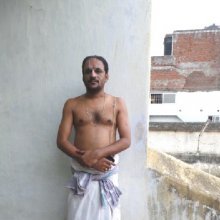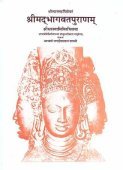Vishnuloka, Viṣṇuloka, Vishnu-loka: 9 definitions
Introduction:
Vishnuloka means something in Hinduism, Sanskrit, Marathi. If you want to know the exact meaning, history, etymology or English translation of this term then check out the descriptions on this page. Add your comment or reference to a book if you want to contribute to this summary article.
The Sanskrit term Viṣṇuloka can be transliterated into English as Visnuloka or Vishnuloka, using the IAST transliteration scheme (?).
Images (photo gallery)
In Hinduism
Purana and Itihasa (epic history)
Source: archive.org: Puranic EncyclopediaViṣṇuloka (विष्णुलोक).—Vaikuṇṭha. It is mentioned in Devī Bhāgavata, Skandha 7, that this world is situated on the top of Mahā Meru along with the worlds of Indra, Agni, Yama, Śiva, Brahmā etc.
Source: archive.org: Shiva Purana - English TranslationViṣṇuloka (विष्णुलोक) refers to fourteen Viṣṇu worlds, as defined in the Śivapurāṇa 1.17. Accordingly, “[...] there are fourteen Viṣṇu worlds (viṣṇuloka) beyond Satya world and ending with Kṣamā. In the Kṣamā world the action—Viṣṇu is stationed in the excellent city of Vaikuṇṭha in the company of action-Lakṣmī protecting the great recipients of enjoyment. Beyond that and ending with Śuciloka there are twenty-eight worlds”.
Source: Cologne Digital Sanskrit Dictionaries: The Purana IndexViṣṇuloka (विष्णुलोक).—The abode of Viṣṇu1 in Pāṇḍaveśam; attained by one who bathes in cakratīrtham;2 he who does tulāpuruṣa goes to Viṣṇulokam.3
- 1) Vāyu-purāṇa 108. 19; 111. 67; Viṣṇu-purāṇa V. 38. 94.
- 2) Matsya-purāṇa 191. 21, 62.
- 3) Ib. 193. 74.

The Purana (पुराण, purāṇas) refers to Sanskrit literature preserving ancient India’s vast cultural history, including historical legends, religious ceremonies, various arts and sciences. The eighteen mahapuranas total over 400,000 shlokas (metrical couplets) and date to at least several centuries BCE.
General definition (in Hinduism)
Source: Wisdom Library: HinduismViṣṇuloka (विष्णुलोक) is a Sanskrit word referring to the abode of Lord Viṣṇu.
Languages of India and abroad
Marathi-English dictionary
Source: DDSA: The Molesworth Marathi and English Dictionaryviṣṇulōka (विष्णुलोक).—m (S) The heaven of Vishn̤u. See vaikuṇṭha.
Source: DDSA: The Aryabhusan school dictionary, Marathi-Englishviṣṇulōka (विष्णुलोक).—m The heaven of viṣṇu, or vaikuṇṭha.
Marathi is an Indo-European language having over 70 million native speakers people in (predominantly) Maharashtra India. Marathi, like many other Indo-Aryan languages, evolved from early forms of Prakrit, which itself is a subset of Sanskrit, one of the most ancient languages of the world.
Sanskrit dictionary
Source: DDSA: The practical Sanskrit-English dictionaryViṣṇuloka (विष्णुलोक).—Viṣṇu's world; मुच्यते सर्वपापेभ्यो विष्णुलोकं स गच्छति (mucyate sarvapāpebhyo viṣṇulokaṃ sa gacchati) Stotra.
Derivable forms: viṣṇulokaḥ (विष्णुलोकः).
Viṣṇuloka is a Sanskrit compound consisting of the terms viṣṇu and loka (लोक).
Source: Cologne Digital Sanskrit Dictionaries: Monier-Williams Sanskrit-English DictionaryViṣṇuloka (विष्णुलोक):—[=viṣṇu-loka] [from viṣṇu] m. V°’s world, [Rājataraṅgiṇī; Viṣṇu-purāṇa; Pañcarātra] ([according to] to some = brahma-l, or [according to] to others, ‘placed above it’ [Monier-Williams’ Sanskrit-English Dictionary])
[Sanskrit to German]
Sanskrit, also spelled संस्कृतम् (saṃskṛtam), is an ancient language of India commonly seen as the grandmother of the Indo-European language family (even English!). Closely allied with Prakrit and Pali, Sanskrit is more exhaustive in both grammar and terms and has the most extensive collection of literature in the world, greatly surpassing its sister-languages Greek and Latin.
See also (Relevant definitions)
Partial matches: Vishnu, Loka.
Full-text: Narayanapura, Lilavrata, Pracisarasvatitirtha, Varahatirtha, Pavanahrada, Tirthakoti, Marakatashala, Sananda, Vaikuntha, Ashunyashayanavrata, Shripancami, Vimukta, Krishnaveni, Vishnuduta, Varahapurana, Narmada, Ajamila, Caidya, Cancalakshi, Gaya.
Relevant text
Search found 26 books and stories containing Vishnuloka, Viṣṇuloka, Vishnu-loka, Viṣṇu-loka, Visnu-loka, Visnuloka, Viṣṇulōka; (plurals include: Vishnulokas, Viṣṇulokas, lokas, Visnulokas, Viṣṇulōkas). You can also click to the full overview containing English textual excerpts. Below are direct links for the most relevant articles:
The Devi Bhagavata Purana (by Swami Vijñanananda)
Chapter 30 - On the conversation between Sāvitrī and Yama and on the fruition of Karmas < [Book 9]
Chapter 29 - On the anecdote of Sāvitrī, on gifts and on the effects of Karmas < [Book 9]
Chapter 5 - On the Gāyatrī Stotra < [Book 12]
Garga Samhita (English) (by Danavir Goswami)
Verse 4.23.9 < [Chapter 23 - The Story of Sudarcana]
Bhakti-rasamrta-sindhu (by Śrīla Rūpa Gosvāmī)
Verse 1.2.104 < [Part 2 - Devotional Service in Practice (sādhana-bhakti)]
The Skanda Purana (by G. V. Tagare)
Chapter 195 - The Glory of Śrīpati < [Section 3 - Revā-khaṇḍa]
Chapter 114 - Greatness of Vāmanasvāmī (Vāmanasvāmin) < [Section 1 - Prabhāsa-kṣetra-māhātmya]
Chapter 188 - The Greatness of Śālagrāma Tīrtha < [Section 3 - Revā-khaṇḍa]
Brihad Bhagavatamrita (commentary) (by Śrī Śrīmad Bhaktivedānta Nārāyana Gosvāmī Mahārāja)
Verse 1.4.113 < [Chapter 4 - Bhakta (the devotee)]
Related products

